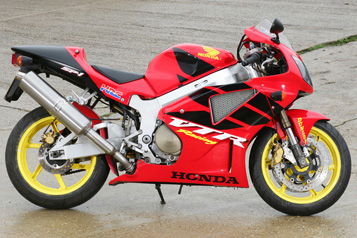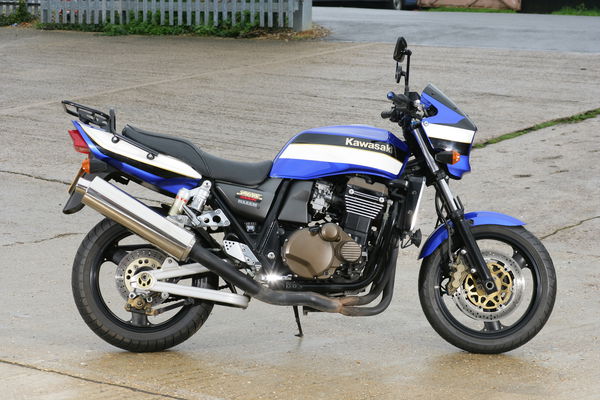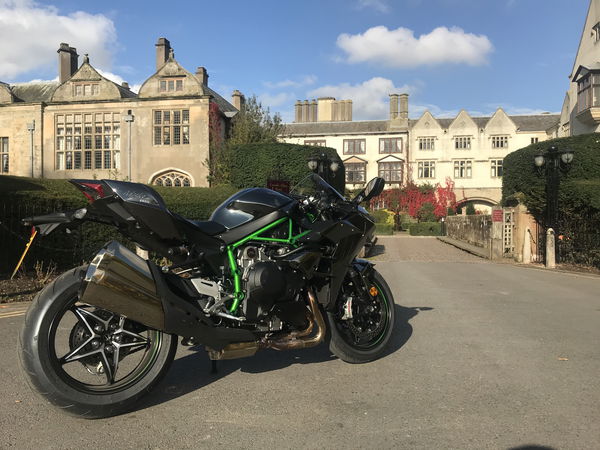Used Review: Honda VTR1000 SP-1 & SP-2
Designed to take on and beat the Ducatis in WSB, the SP-1 and SP-2 did just that. But how does it fare in the more cut-throat world of used sales? Bertie Simmonds finds out.

 |
If you can't beat 'em, join 'em. So said Honda at the end of 1999 when it unveiled the VTR1000 SP-1.
Back in the day, World Superbikes was a race series between 750cc fours (made by the Japs) and the 1000cc V-twins favoured by the Italians. With only four titles from 1988 to 1999, it was clear the inline and V-fours were struggling.Thus, Honda made this: the SP-1, a 999cc, liquid-cooled four-valve per head 'Japcati' that looked great, oozed class, was finished superbly and about as practical as a 996. It was cheaper though, being under £10K. It won WSB first time out with Colin Edwards, but on the road this thing had more snatch than a porn library and was almost as hairy if you gave it a handful. Thankfully new injector bodies on the SP-2 gave the roadbike a major leg-up on the ease of use scale, and helped Colin to a second title. Still officially on sale, the SP-2 is now an over-priced, under-powered V-twin alternative to the raft of 1000cc fours (oh, the irony) but as a used bike, it's a much better bet.
Engine
After the initial snatchi-ness (SP-1 only) the motor picks up nicely from 4000rpm, dips for emissions and then takes off on a almost 45-degree line towards an 120bhp top end as standard. The SP series love to rev, which is nice. Big change from SP-1 to SP-2 (see 'Second-Hand Values') was the bigger throttle bodies and smoother low-down delivery. Servicing should take place generally every 4000 miles. The big one is the 16,000-miler which demands a good look at the valve clearances.
Oil consumption
Many owners advise keeping a close eye on it.
Top-end noise
Some owners report a top-end tapping noise when opening the throttle on the SP-1/2. It's perfectly normal, and no, it's not the cam-chain tensioners as the SP series has gear-driven cams!
Rough running
Owners have reported SPs stalling or failing to run correctly. If this happens with a machine you're interested in buying ask how long the fuel has been in the tank and when the bike was last serviced. Why? Old fuel and old plugs are the biggest cause of poor running, according to owners.
Alarms and engine cut-out
Warning! A few owners have reported that some alarms fry the wiring or cause the ignition to cut out. Immobilisors have also been known to do the same. If fitted, make sure it's a professional installation.
Clutch
Can be grabby according to some, so test ride before you buy.
Gearbox
One owner reported his bike jumping out of third gear with less than 5000 miles on the clock. Another said his 17,000-miler SP-1 was hitting false neutrals under load after gearchanges. His dealer told him to buy a whole new gearbox. This is not the norm: these bikes are typically solid. A good test ride will establish whether the one in question is sound.
Gearing
A number of owners go a tooth down (15 from 16) at the front at the expense of top-end.
Brakes
Excellent pre-radial Nissin calipers are common to the SP-1 and 2. Big discs and well-matched components ensure mighty stopping power.
Suspension
Showa suspension on the early SP-1s was hard to set-up correctly at the back. The forks were always spot-on after some fiddling, but the rear either seemed too hard or too soft. On the SP-2 work was done to address this and it worked - to a point (see handling).
Handling
The SP-2 addressed the rear-suspension ambiguity of the SP-1, but instead the bike now came out of the showroom too low at the back to really turn well. Kept it stable though, and meant no steering damper was required as standard. With plenty of grip at the rear, Niall's advice was to jack the back-end up to make the SP-2 turn. Owners generally reckon on dropping the forks through the yokes anything from 5-10mm and jacking up the rear a little with spacers under the top of the shcok mount. Consult an expert if you're unsure about how far to go.
Hero blobs
Honda call 'em 'bank angle sensors', and they're enormous. Many owners remove them, but bear in mind the next thing to touch down -the exhaust - is much more solid. If you jack the back end up to raise the rear ride height and improve turn-in (see above) you'll improve ground clearance too.
Comfort
Not quite as extreme as a 996/998 of the same period to ride, but close enough. Meaning a wee bit tough on the road, but sublime, truly sublime, on the track.
Finish
Absolutely superb.
Tyres
Bridgestones are most heartily recommended. The BT-014 is current fave, as BT-010s were in the past on the SP-1. Pirelli's and Metzeler's sporty offerings are well thought of if you're after stability and feedback, as are Michelins for ultimate grip and razor responses.
Fuel range/economy
If the piss-poor tank range (sometimes as little as 70-80 miles from the 18-litres to reserve) annoys, QB Carbon make a very trick 21-litre tank. Made to order, it'll cost you £940. Have a look at www.worldofqbcarbon.com
Used values
Fairly robust. The irony is that initially - at just under £10,000 - the SP-1 was considered good value compared to the Ducatis, if not the Aprilia twins. But as the time of the litre class four-cylinder sportsbike approached, the bike sat at the wrong end of the new bike price spectrum.
Aftermarket parts
Hanging baubles on the SP-1 and SP-2 is not the done thing. Expect to see tasteful end cans and pipes only. Anything with a tail-tidy, coloured lens covers and the like should be avoided: this thing will be a future classic, so KISS - Keep It Standard, Stupid. That said, Harris - who raced SP-1s in BSB with Sean Emmett and Shane Byrne, know the machines well and make a myriad of decent bits for 'em.
Recalls
None reported on the Vehicle Inspectorate website.
SECOND-HAND VALUES
All our prices are sourced from genuine trade and private ads in a variety of real-world publications. Read it, believe it!
Honda VTR1000 SP-1 (1999-2001)
Colours: Honda red
Price new: £9999 (2001)
Price now: £2900-£6000
Comments: The original Ducati-beater. The SP-1/RC51 came with 120 real-world bhp, a terrible off-on low-down power delivery, trick, if a touch impractical, LCD rev-counter and amazingly gorgeous good looks. It only came in red, though. Legend has it that the frame design came straight from Doohan's NSR500.
Honda VTR1000 SP-2 (2001-2006)
Colours: White, black/red
Price new: £11,399 (2002)
Price now: £6000-£8000
Comments: New 62mm throttle bodies (up from 54mm) with twin injectors and reshaped exhaust ports mean power delivery is much improved, and up by 4bhp. A new HRC-designed swingarm aped the factory WSB racer's, being 700g lighter and 10mm longer. The frame looks similar but is extensively modified. Then there's new wheels, new silencers, a 30mm taller screen (again, as used by Colin) making for marginally better rider protection, while sleeker indicators looked sportier. The SP-2 was much more than a makeover. The new white and black colours looked trick too.

If you can't beat 'em, join 'em. So said Honda at the end of 1999 when it unveiled the VTR1000 SP-1.
Back in the day, World Superbikes was a race series between 750cc fours (made by the Japs) and the 1000cc V-twins favoured by the Italians.
With only four titles from 1988 to 1999, it was clear the inline and V-fours were struggling.Thus, Honda made this: the SP-1, a 999cc, liquid-cooled four-valve per head 'Japcati' that looked great, oozed class, was finished superbly and about as practical as a 996. It was cheaper though, being under £10K. It won WSB first time out with Colin Edwards, but on the road this thing had more snatch than a porn library and was almost as hairy if you gave it a handful.
Thankfully new injector bodies on the SP-2 gave the roadbike a major leg-up on the ease of use scale, and helped Colin to a second title. Still officially on sale, the SP-2 is now an over-priced, under-powered V-twin alternative to the raft of 1000cc fours (oh, the irony) but as a used bike, it's a much better bet.
1. Engine: After the initial snatchi-ness (SP-1 only) the motor picks up nicely from 4000rpm, dips for
emissions and then takes off on a almost 45-degree line towards an 120bhp top end as standard. The SP series love to rev, which is nice. Big change from SP-1 to SP-2 (see 'Second-Hand Values') was the
bigger throttle bodies and smoother low-down delivery. Servicing should take place generally every 4000 miles. The big one is the 16,000-miler which demands a good look at the valve clearances.
2. Oil consumption: Many owners advise keeping a close eye on it.
3. Top-end noise: Some owners report a top-end tapping noise when opening the throttle on the SP-1/2. It's perfectly normal, and no, it's not the cam-chain tensioners as the SP series has gear-driven cams!
4. Rough running: Owners have reported SPs stalling or failing to run correctly. If this happens with a machine you're interested in buying ask how long the fuel has been in the tank and when the bike was last serviced. Why? Old fuel and old plugs are the biggest cause of poor running, according to owners.
5. Alarms and engine cut-out: Warning! A few owners have reported that some alarms fry the wiring or cause the ignition to cut out. Immobilisors have also been known to do the same. If fitted, make sure it's a professional installation.
6. Clutch: Can be grabby according to some, so test ride before you buy.
7. Gearbox: One owner reported his bike jumping out of third gear with less than 5000 miles on the clock. Another said his 17,000-miler SP-1 was hitting false neutrals under load after gearchanges. His dealer told him to buy a whole new gearbox. This is not the norm: these bikes are typically solid. A good test ride will establish whether the one in question is sound.











